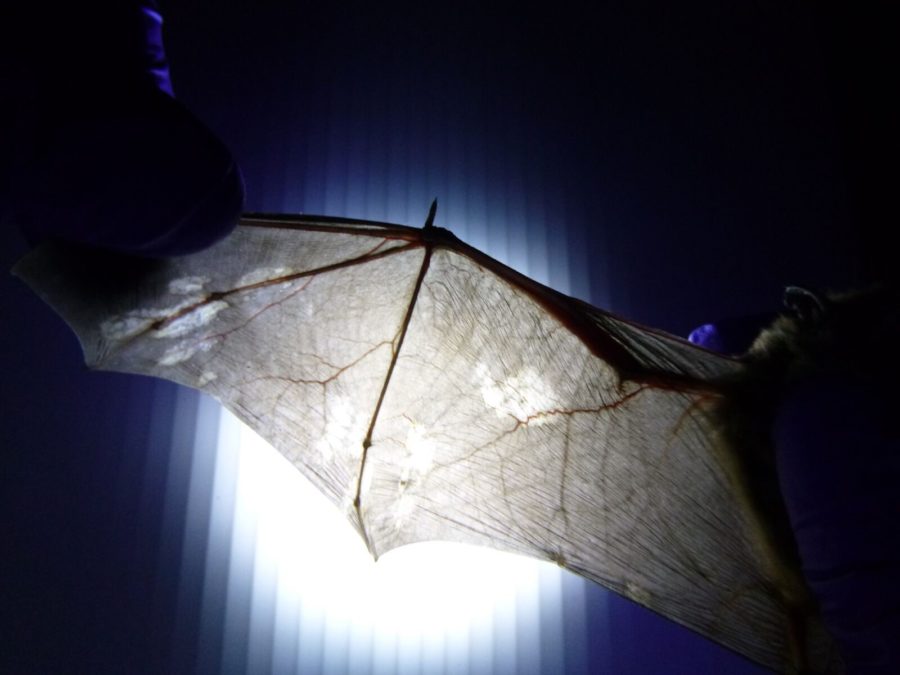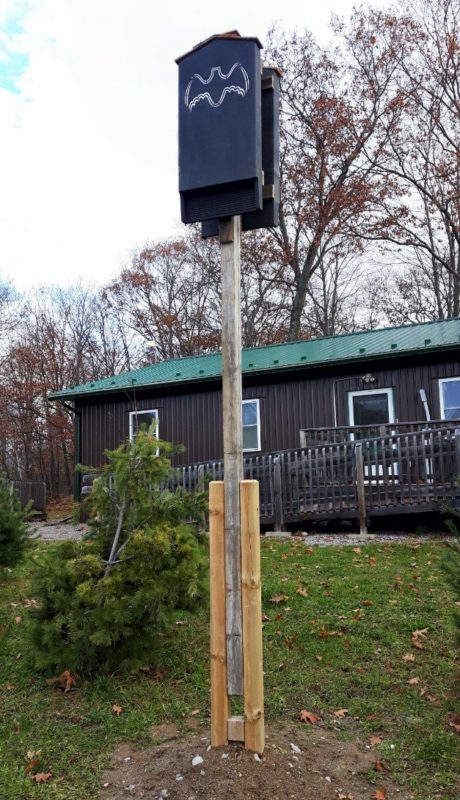In today’s post, Biologist Intern Michelle Lawrence gives us an insider look at Killarney’s “nightlife,” and shares how staff are working to protect the park’s bat populations.
Killarney Provincial Park has been called “a crown jewel of the provincial parks system” by some, and it’s not hard to see why.
With white quartzite mountains and sparkling blue lakes, Killarney is truly a sight to behold. In Killarney’s wilderness, White Pine grow, live, and die; Moose munch on water lilies; and the forests and wetlands teem with warblers and other songbirds.
But when the sun goes down, not everyone in the park goes to sleep…
Killarney’s “nightlife”
 The park boasts a glittering night sky that experiences little influence from human light sources. Killarney recently became Ontario’s first provincial park to receive a Dark Sky Preserve designation from the Royal Astronomical Society of Canada.
The park boasts a glittering night sky that experiences little influence from human light sources. Killarney recently became Ontario’s first provincial park to receive a Dark Sky Preserve designation from the Royal Astronomical Society of Canada.
The star-filled sky itself is worth staying up for, but what happens when the sun sets and you crawl into your tent?
The “night shift” takes over.

Barred Owls make their haunting calls, often right in the George Lake Campground. Eastern Whip-poor-wills sing and sing…and sing. A chorus of Spring Peepers may chime in. Moths flutter through the night in search of a mate.
And bats — one of the most misunderstood “creatures of the night” — leave their roost.
Here at Killarney, we love our bats
Next time you attend an evening amphitheatre program or are sitting around your campfire, look up: you may be lucky enough to spot a bat flying overhead.

This is not an uncommon occurrence in the park. Killarney is home to a fairly large number of Little Brown Bats during the summer months.
We are thrilled to have them. Bats are important predators of nocturnal flying insects and a vital part of Killarney’s ecosystems.
Don’t bats spend all their time in caves?
Contrary to popular belief, our bats do not “hang out” in caves all the time.

During the summer months females seek out warm roosts (up to 38 degrees Celsius!) for shelter during the daytime and to raise their young. These roosts are often nooks and crannies in trees or buildings with sun exposure on the outside making it warm inside.
In Killarney, we find bats roosting behind signs, and even in tiny spaces in a door frame.
Did you know moths are one of bats favourite foods?
Bats and moths have evolved together over millennia, playing an aerial cat and mouse game. Moths are full of nutrients that bats, especially mothers with pups, need to consume.
Bats use echolocation to “see” their surroundings in the dark – they bounce high pitched calls off objects, including moths, and those sounds reflect back to the bat’s ears, allowing the bat to avoid obstacles and catch moths.

Large-bodied moths like the One-eyed Sphynx, Luna and Cecropia provide bats with a large meal and lots of nutrients. Bats help to control moth populations, whose caterpillars are hungry leaf-eaters.
A black light with a white sheet is an effective way to attract and survey moths for monitoring purposes, or park programs.

The chess match evolves
Some moths can detect bat echolocation calls and have developed ways to avoid bats. Some species simply stop flying, and drop quickly out of the bat’s flight path. Luna Moths have long “tails” to their hind wings, and these seem to confuse bats homing in on the moth’s juicy body.
Amazingly, some moths even have the ability to make a high-pitched noise that jams the bat’s sonar, allowing the moth to escape.

Scientists have also discovered that some moths even have stealth technology! As we mentioned earlier, some moth species can detect echolocation because they have evolved ears.
However most moths are deaf, so, instead, they’ve evolved to be furry. The fur absorbs the bat’s echolocating calls, making the moth virtually invisible to bats.
We need to protect our bats
Little Brown Bats were once incredibly abundant. Now, we are at risk of losing them because of White-nose Syndrome.
White-nose Syndrome affects hibernating bats by causing them to wake more frequently, and search for food and water when it isn’t available. This burns precious fat stores and eventually leads to the bat’s death.

This disease is caused by a cold-loving, non-native fungus that was first identified in New York State in 2006. It has rapidly spread eastward and into Canada and has killed an estimated 6 million bats!
How is Killarney helping?
During the summer bats are not as susceptible to White-nose Syndrome. The fungus that causes the disease thrives in cool, humid conditions that can be found inside caves.

As well, the fungus can’t survive the summertime temperature of a bat’s body, but when the bat drops its body temperature during hibernation, the fungus can take hold.
For this reason, Killarney wants to make the park a better home for bats during the summer by providing them with new summer homes. We hope that White-nose Syndrome survivors will be able to grow the population of Little Brown Bats once again.
The park’s new experimental bat house
This summer, bat researchers from the University of Winnipeg visited the park and installed a heated bat house – one of many installed around Ontario and Manitoba.

They hope that these heated bat houses will enhance maternity roosting habitat for these animals and result in more young bats surviving the summer.
Bats really seem to like the heated houses, but the results of the experiment have not yet been finalized and they don’t yet recommend using heated bat houses outside of their experiment.
Stay tuned!
Even more bat housing
 We also embarked on our own project to make the park a better home for bats by installing more bat houses.
We also embarked on our own project to make the park a better home for bats by installing more bat houses.
In 2019, you’ll be able to see one of our new bat houses near Killarney’s observatory.
We installed the houses this fall, so these new housing options will be available in spring 2019 when bats return to the park from their hibernation sites. We carefully selected good quality bat houses and suitable locations.
Bats are more likely to move in if houses are in the perfect spot and are well-constructed.
This is what we looked when we located the new bat houses:
- Weather-proof. The bat house should be weather proof, or installed below eaves (or both!). How would you feel if your roof leaked?
- A good landing pad. Bats fly back to their houses to roost, and when they get back to their house, they need a fairly large rough or grooved landing pad so they have enough space to land and so they can hang on. The inside surfaces of the house should also have texture that helps bats hold on.
- Location, location, location. Bats like warm roosts, their houses should be installed in a spot that gets sun for most of the day. They particularly seem to like houses installed on buildings, but large houses installed on tall poles are also suitable. Houses installed on trees tend to have too much shade.
- Narrow chambers. The narrowness helps keep bats out of reach of predators, discourages wasps from moving in, and reduces air flow, keeping things warm.
Want to build your own bathouse? Our friends at Bat Conservation International have some great resources.
We’re not done yet!
Installing bat houses is just part of the project; we’re planning to continue monitoring bat populations in the park, and documenting moth diversity.
If you’re interested in learning more about these fascinating creatures or helping to monitor them, attend an evening bat or moth program in Killarney next summer.

We hope you’ll be able to catch a glimpse of a bat leaving the new bat house for the evening, and get an up-close look at some moths and other nocturnal insects.

Follow Killarney Provincial Park on social media (@KillarneyPP is on Twitter, Facebook and Instagram during the spring, summer and fall), and stay tuned to our events page for programs on bats, moths and astronomy each summer.
To help celebrate Ontario Parks’ 125th anniversary, parks across the province are hosting 13 stewardship programs to help protect biodiversity in provincial parks.
